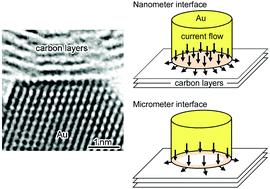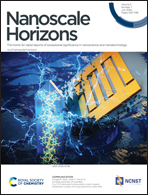Crossing interfacial conduction in nanometer-sized graphitic carbon layers†
Abstract
Graphitic carbon layers (GCLs), exemplified by graphene, have been proposed for potential application in high-performance functional devices due to superior electrical properties, e.g., high electron mobility. In state-of-the-art electronics, it is required that GCLs are miniaturized to nanometer scales and incorporated into the integrated circuits to exhibit novel functions at nanometer scales. However, the implementation of nanometer-scale GCLs is suspended; the function in devices is deteriorated by increasing contact resistance in miniaturized GCL/electrode interfaces. In this study, nanometer-sized GCL/gold (Au) interfaces were fabricated via atomistic visualization of nanomanipulation, and simultaneously their contact resistance was measured. We showed that the contact resistivity of the interfaces was decreased to the order of 10−10 Ω cm2, which was 104 times smaller than that of micrometer-sized or larger GCL/metal interfaces. In addition, it was revealed that peculiar electrical conduction at the nanometer-sized GCL/Au interfaces emerged; current flows throughout the entire area of the interfaces unlike micrometer-sized or larger GCL/metal interfaces. These results directly contribute to actual application of GCLs in advanced nanodevices.



 Please wait while we load your content...
Please wait while we load your content...